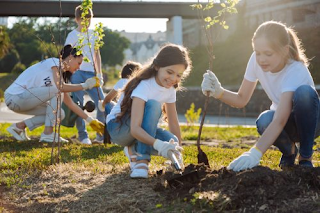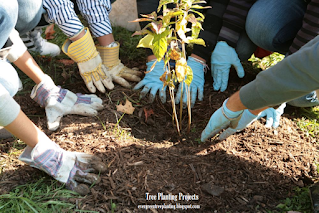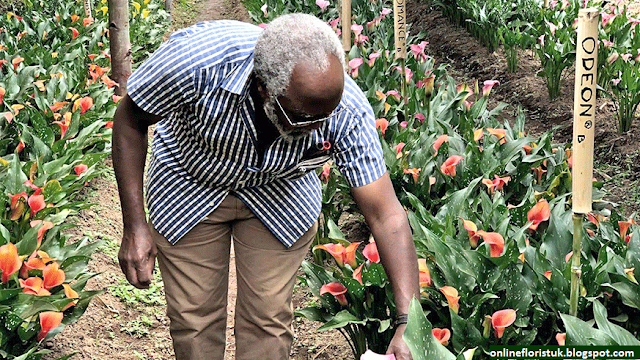Best 10 typical tree planting projects - "Tree Planting" and "Reforestation" Projects in the world. This Blog is about reforestation. You can find here Tree Planting Projects, reforestation, billion tree project.
 |
| Tree Planting Projects |
There are numerous ventures that are attempting to develop plants each day, consistently on the planet. It happens in various areas, however, the general motivation behind the activities is to reestablish, secure the woodland — valuable assets, the green lung of humankind.
 | |
|
1. TreeChain Network's 11 billion trees project on the planet
TreeChain Network is a worldwide undertaking dispatched in December 2017 in Australia with the mission of "Make Our Planet Green Again", to ceaselessly create and ensure the status of the essential woodland framework on the planet. TreeChain Network will actualize 4.0 innovation, utilizing biochip, blockchain to plant and oversee trees. The objective in the following ten years is to interface all local area assets to plant 11 billion new trees all around the world.
The exceptional component of the undertaking is the use of blockchain innovation to tree planting and local area availability through the treemap framework. Accordingly, just in the main year of dispatch, the task has gotten the help of the legislatures of 12 nations around the planet, the esteemed NGO for natural assurance.
GROWING ROSES HOW TO PLANT || Top Ten Flower Trees.
2. Undertaking to plant 73 million trees to help recover woodlands in the Amazon
As per IFL Science, Conservation International will execute an undertaking to plant 73 million trees in the Amazon district by 2023. This is the biggest tropical reforestation project on the planet. In the wake of planting, the new backwoods cover will cover about 30,000ha of land and will impact affect endless types of timberland and atmosphere on Earth.
3. 50 million trees plant task of the Government of Ontario
The Ontario government has promised to plant 50 million trees by 2025. The 50 million tree program is propelled by worldwide endeavors to grow billions of trees around the globe every year. Up to right now, the task has called for around 4,000 mortgage holders to have planted land. The undertaking plans to improve the nature of the land and to reestablish territory for untamed life. Simultaneously, improving the climate and opening up a superior future for the future. 2222
4. The undertaking planted 9 million trees of Ethiopian Airlines
On 21 March 2018, the United Nations Environment Fund marked a Memorandum of Understanding with Ethiopian Airlines, zeroing in on manageability in the aeronautics business. The objective of the task is to plant 9 million trees under the name of Ethiopian Airlines in various pieces of Ethiopia. Each plant will be planted in various pieces of Ethiopia.
Recommend for You:
- Best Live House Plants for Clean Air-Large White Indoor Planter
- Unique Real-Live Succulent Plants- Special Gift Tree-Live Indoor Plants
- Fiddle Leaf Plant-Costa Farms Ficus Lyrata Fiddle Leaf Fig Tree-"Live Indoor Plants"
- North Privet Hedge Home Depot
- Tree Form Hydrangea Care-Tree Planting
- Top 10 Fast Growing Trees in the World
- Fast Growing Privacy Trees for Privacy Zone "Tree Planting"
- Yoshino Cherry Tree - Prunus Yedoensis
- Top ten anti-aging product
- Low Light Indoor Trees-AMERICAN PLANT EXCHANGE Dwarf Pomegranate Bush Indoor/Outdoor Air Purifier Live Plant, 6" Pot, Fruit Producing
- Low Light Indoor Trees-Golden Gate Ficus Bonsai
- Low Light Indoor Trees - "Burgundy Rubber Plant" - Ficus - an Old Favorite - 6" Pot
- Zanzibar Gem Plant- "Zanzibar Gem" Care and Benefits
- Best Vintage Home Sunny Isles Artificial Tree Tips You Will Read This Year
- Best Artificial Christmas Trees for Home, Office, Party Decoration- "Artificial XMAS Trees"
5. Task to plant 50 million trees by 2023 of the National Forest Foundation
The US National Forest Service is putting forth an aggressive attempt to plant 50 million trees in the National Forest by 2023. The objective is to reestablish a huge number of sections of land of cataclysmic event Florida pines to Alaska cedar gardens. Simultaneously, stream bowls give feasible assets to the existences of the urban areas of Los Angeles, Atlanta, Seattle, and a great many different networks. What's more, as they develop, they will help battle worldwide environmental change and guarantee that natural life has a solid spot to live. 3333
6. Undertaking to plant 50 million trees in a single day in India
As per the Telegraph, India has effectively actualized a venture to plant 50 million trees along public thruways, freeways, rail lines, and backwoods land within 24 hours in Uttar Pradesh. The venture has included in excess of 800,000 volunteers including understudies, administrators, government authorities, housewives, and volunteers from various non-legislative associations in India. The manor project has tackled a considerable lot of India's issues specifically and the world as a rule, for example, contamination, deforestation, and land use.
7. Undertaking of Tree Roots and Shoots (MTP) of Shanghai
This venture began in 2007, intending to bring issues to light about the valuable climate of the Earth. The undertaking has helped people and associations comprehend that every one of them can add to battling environmental change by planting oxygen-creating plants. The task is as yet in progress in Shanghai and has gotten dynamic investment from the local area.
8. The task planted 847,275 trees one day in Pakistan
In 2013, America executed 847,275 planting projects in a single day. This task was embraced by beachfront networks, volunteers, and staff from the Forestry Department of Pakistan.
9. Australia's 1 billion trees project
In Australia, there is a day called the National Tree Day, which interprets as the National Tree Day. This day is held yearly via Planet Arktrong a week ago in July, reassuring the general population to plant 1 million local trees every year.
10. The Helena National Reforestation Project
In the spring of 2013, 8,500 pine trees were planted around Helena's officer station. These seedlings are painstakingly planted and breastfed to guarantee ideal endurance for recently planted trees. These seedlings are an incredible present for the timberland and the individuals here. They help guarantee the recovery of the timberland and give a significant wellspring of seed for different woods later on.
 | |
|
Recommend for you:
- Happy Birthday Special Lady
- Funny Good night Quotes and Funny Good night Message
- Good morning son Text and SMS
- German Shepherd Quotes
- Message to my daughter and Message for daughter
- Good Morning Message: Good Morning My Son
- Quotes for Congratulations on Your Master's Degree
- Good Morning Messages for Friends
- Short Christmas Quotes
- Good Night Love Messages - "Good Night Love You"
- Good Night Messages For Friends
- Love good nite Sweet Good Night Messages for Her
- Good morning Massage








